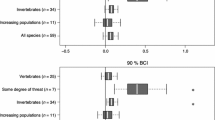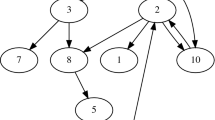Abstract
The spatial arrangement of habitat patches in a metapopulation and the dispersal connections among them influence metapopulation persistence. Metapopulation persistence emerges from a dynamic process, namely the serial extinctions and recolonizations of local habitat patches, while measures of persistence are typically based solely on structural properties of the spatial network (e.g., spatial distance between sites). Persistence estimators based on static properties may be unable to capture the dynamic nature of persistence. Understanding the shape of the distribution of extinction times is a central goal in population ecology. Here, we examine the goodness of fit of the power law to patch persistence time distributions using data on a foundational metapopulation system—the Glanville fritillary butterfly in the Åland islands. Further, we address the relationship between structural measures of metapopulation persistence (i.e., metapopulation capacity) and our temporal distributional fits to patch persistence times based on a power law. Patch persistence time distributions were well fit by a power law for the majority of semi-independent networks. Power law fits to persistence time distributions were related to metapopulation capacity, linking structural and temporal measures of metapopulation persistence. Several environmental variables and measures of network topology were correlated with both measures of metapopulation persistence, though correlations tended to be stronger for the structural measure of metapopulation persistence (i.e., metapopulation capacity). Together, our findings suggest that persistence time distributions are useful dynamic properties of metapopulations, and provide evidence of a relationship between metapopulation structure and metapopulation dynamics.




Similar content being viewed by others
Data availability
R code is available on figshare at https://doi.org/10.6084/m9.figshare.12576038.
References
Albert R, Jeong H, Barabási AL (2000) Error and attack tolerance of complex networks. Nature 406(6794):378
Barrat A, Barthelemy M, Vespignani A (2007) The architecture of complex weighted networks: Measurements and models. In: Large scale structure and dynamics of complex networks: from information technology to finance and natural science, world Scientific, pp 67–92
van Bergen E, Dallas T, DiLeo MF, Kahilainen A, Mattila AL, Luoto M, Saastamoinen M (2020) The effect of summer drought on the predictability of local extinctions in a butterfly metapopulation. Conservation Biology
Bertuzzo E, Suweis S, Mari L, Maritan A, Rodríguez-iturbe I, Rinaldo A (2011) Spatial effects on species persistence and implications for biodiversity. Proceedings of the National Academy of Sciences
Chen S, O’Dea EB, Drake JM, Epureanu BI (2019) Eigenvalues of the covariance matrix as early warning signals for critical transitions in ecological systems. Sci Rep 9(1):1–14
Clauset A, Shalizi CR, Newman ME (2009) Power-law distributions in empirical data. SIAM Rev 51(4):661–703
Csardi G, Nepusz T (2006) The igraph software package for complex network research. InterJournal Complex Systems:1695. http://igraph.org
Dallas TA, Saastamoinen M, Schulz T, Ovaskainen O (2019) The relative importance of local and regional processes to metapopulation dynamics. J Anim Ecol 89(3):884–896. https://doi.org/10.1111/1365-2656.13141
Diekmann O, Heesterbeek J, Roberts MG (2010) The construction of next-generation matrices for compartmental epidemic models. J R Soc Interface 7(47):873–885
Doebeli M (1995) Dispersal and dynamics. Theor Popul Biol 47(1):82–106
Drake JM (2006) Extinction times in experimental populations. Ecol 87(9):2215–2220
Drake JM (2014) Tail probabilities of extinction time in a large number of experimental populations. Ecol 95(5):1119–1126
Ebel H, Mielsch LI, Bornholdt S (2002) Scale-free topology of e-mail networks. Phys Rev E 66(3):035103
Fleishman E, Ray C, Sjögren-Gulve P, Boggs CL, Murphy DD (2002) Assessing the roles of patch quality, area, and isolation in predicting metapopulation dynamics. Conserv Biol 16(3):706–716
Fletcher RJ Jr, Revell A, Reichert BE, Kitchens WM, Dixon JD, Austin JD (2013) Network modularity reveals critical scales for connectivity in ecology and evolution. Nat Commun 4:2572
Gilarranz LJ, Rayfield B, Liñán-Cembrano G, Bascompte J, Gonzalez A (2017) Effects of network modularity on the spread of perturbation impact in experimental metapopulations. Science 357 (6347):199–201
Gillespie CS (2015) Fitting heavy tailed distributions: The poweRlaw package. J Stat Softw 64 (2):1–16. http://www.jstatsoft.org/v64/i02/
Hanski I (1994) A practical model of metapopulation dynamics. Journal of animal ecology, pp 151–162
Hanski I (1999) Metapopulation ecology. Oxford series in ecology and evolution, OUP Oxford, England
Hanski I (2011) Habitat loss, the dynamics of biodiversity, and a perspective on conservation. Ambio 40(3):248–255
Hanski I, Gilpin M (1991) Metapopulation dynamics: brief history and conceptual domain. In: Metapopulation dynamics: Empirical and theoretical investigations. Elsevier, Amsterdam, pp 3–16
Hanski I, Ovaskainen O (2000) The metapopulation capacity of a fragmented landscape. Nature 404(6779):755
Hanski I, Thomas CD (1994) Metapopulation dynamics and conservation: a spatially explicit model applied to butterflies. Biol Conserv 68(2):167–180
Hanski I, Schulz T, Wong SC, Ahola V, Ruokolainen A, Ojanen SP (2017) Ecological and genetic basis of metapopulation persistence of the glanville fritillary butterfly in fragmented landscapes. Nat Commun 8:14504
Harrison S, Taylor AD (1997) Empirical evidence for metapopulation dynamics. In: Metapopulation biology. Elsevier, Amsterdam, pp 27–42
Holland MD, Hastings A (2008) Strong effect of dispersal network structure on ecological dynamics. Nature 456(7223):792
Holmes CJ, Rapti Z, Pantel JH, Schulz KL, Cáceres CE (2020) Patch centrality affects metapopulation dynamics in small freshwater ponds. Theoretical Ecology, 1–14
Johst K, Brandl R, Eber S (2002) Metapopulation persistence in dynamic landscapes: the role of dispersal distance. Oikos 98(2):263–270
Kamra A, Misra V, Feldman J, Rubenstein D (2006) Growth codes: Maximizing sensor network data persistence. In: ACM SIGCOMM Computer communication review, ACM, vol. 36, pp 255-266
Kéfi S, Rietkerk M, Alados CL, Pueyo Y, Papanastasis VP, ElAich A, De Ruiter PC (2007) Spatial vegetation patterns and imminent desertification in mediterranean arid ecosystems. Nature 449 (7159):213–217
Keitt TH, Stanley HE (1998) Dynamics of north american breeding bird populations. Nature 393(6682):257–260
Keymer JE, Marquet PA, Velasco-Hernández JX, Levin SA (2000) Extinction thresholds and metapopulation persistence in dynamic landscapes. Am Nat 156(5):478–494
Kleinberg JM (1999) Authoritative sources in a hyperlinked environment. J ACM (JACM) 46 (5):604–632
Kleinhans D, Jonsson PR (2011) On the impact of dispersal asymmetry on metapopulation persistence. J Theor Biol 290:37–45
Levins R (1969) Some demographic and genetic consequences of environmental heterogeneity for biological control. Am Entomol 15(3):237–240
Marquet PA, Quiñones RA, Abades S, Labra F, Tognelli M, Arim M, Rivadeneira M (2005) Scaling and power-laws in ecological systems. J Exp Biol 208(9):1749–1769
Martín HG, Goldenfeld N (2006) On the origin and robustness of power-law species–area relationships in ecology. Proc Natl Acad Sci 103(27):10310–10315
McCarthy MA, Thompson CJ, Possingham HP (2004) Theory for designing nature reserves for single species. Am Nat 165(2):250–257
McCullough DR (1996) Metapopulations and wildlife conservation. Island Press
Moilanen A (2002) Implications of empirical data quality to metapopulation model parameter estimation and application. Oikos 96(3):516–530
Molofsky J, Ferdy JB (2005) Extinction dynamics in experimental metapopulations. Pro Natl Acad Sci 102(10):3726–3731
Morse D, Lawton J, Dodson M, Williamson M (1985) Fractal dimension of vegetation and the distribution of arthropod body lengths. Nature 314(6013):731–733
Nicholson E, Ovaskainen O (2009) Conservation prioritization using metapopulation models. Spatial conservation prioritisation: quantitative methods and computational tools Oxford University Press, Oxford UK, pp 110–121
van Nouhuys S, Laine AL (2008) Population dynamics and sex ratio of a parasitoid altered by fungal-infected diet of host butterfly. Proc R Soc B Biol Sci 275(1636):787–795
Ojanen SP, Nieminen M, Meyke E, Pöyry J, Hanski I (2013) Long-term metapopulation study of the glanville fritillary butterfly (melitaea cinxia): survey methods, data management, and long-term population trends. Ecol Evol 3(11):3713–3737
Ovaskainen O, Hanski I (2001) Spatially structured metapopulation models: global and local assessment of metapopulation capacity. Theor Popul Biol 60(4):281–302
Ovaskainen O, Hanski I (2002) Transient dynamics in metapopulation response to perturbation. Theor Popul Biol 61(3):285–295
Ovaskainen O, Hanski I (2003) How much does an individual habitat fragment contribute to metapopulation dynamics and persistence? Theor Popul Biol 64(4):481–495
Pons P, Latapy M (2005) Computing communities in large networks using random walks. In: International symposium on computer and information sciences, Springer, pp 284–293
Rothenberg R (2001) How a net works: implications of network structure for the persistence and control of sexually transmitted diseases and hiv. Sex Transm Dis 28(2):63–68
Saha S, Adiga A, Prakash BA, Vullikanti AKS (2015) Approximation algorithms for reducing the spectral radius to control epidemic spread. In: Proceedings of the SIAM international conference on data mining, SIAM, pp 568–576, vol 2015
Staniczenko PP, Kopp JC, Allesina S (2013) The ghost of nestedness in ecological networks. Nat Commun 4(1):1–6
Thomas C (1994) Extinction, colonization, and metapopulations: environmental tracking by rare species. Conserv Biol 8(2):373–378
Tollenaere C, Pernechele B, Mäkinen H, Parratt S, Németh M, Kovács G, Kiss L, Tack A, Laine AL (2014) A hyperparasite affects the population dynamics of a wild plant pathogen. Mol Ecol 23(23):5877–5887
Visconti P, Elkin C (2009) Using connectivity metrics in conservation planning–when does habitat quality matter? Divers Distrib 15(4):602–612
Vuilleumier S, Bolker BM, Lévêque O (2010) Effects of colonization asymmetries on metapopulation persistence. Theor Popul Biol 78(3):225–238
White EP, Enquist BJ, Green JL (2008) On estimating the exponent of power-law frequency distributions. Ecol 89(4):905–912
Wu Y, Shindnes G, Karve V, Yager D, Work DB, Chakraborty A, Sowers RB (2017) Congestion barcodes: Exploring the topology of urban congestion using persistent homology. In: Intelligent transportation systems (ITSC), 2017 IEEE 20th international conference on, IEEE, pp 1–6
Zamborain-Mason J, Russ GR, Abesamis RA, Bucol AA, Connolly SR (2017) Network theory and metapopulation persistence: incorporating node self-connections. Ecol Lett 20(7):815–831
Acknowledgments
We thank the coordinators and volunteers who participated in the Åland island survey since 1993. The Research Centre for Ecological Change is funded by the Jane and Aatos Erkko Foundation. TAD thanks the Department of Mathematics at University of Rijeka for their hospitality.
This work has been performed with funding to Tad Dallas from the National Science Foundation (NSF-DEB-2017826) Macrosystems Biology and NEON-Enabled Science program.
Author contributions
TAD designed the study and performed the analyses. All authors contributed to manuscript writing.
Funding
The research was funded by the Academy of Finland (grant 309581 to OO), the Research Council of Norway (SFF-III grant 223257), and the European Research Council (Independent Starting grant no. 637412 ‘META-STRESS’ to MS)
Author information
Authors and Affiliations
Corresponding author
Ethics declarations
Ethics approval and consent to participate
This work required no ethics approval, and all authors contributed to this project.
Consent for publication
All authors approved the submission of this work.
Competing interests
The authors declare that they have no conflicts of interest.
Electronic supplementary material
Below is the link to the electronic supplementary material.
Rights and permissions
About this article
Cite this article
Dallas, T.A., Saastamoinen, M. & Ovaskainen, O. Exploring the dimensions of metapopulation persistence: a comparison of structural and temporal measures. Theor Ecol 14, 269–278 (2021). https://doi.org/10.1007/s12080-020-00497-0
Received:
Accepted:
Published:
Issue Date:
DOI: https://doi.org/10.1007/s12080-020-00497-0




